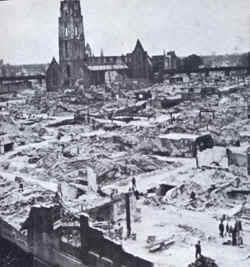Germany invaded Holland on May 10th 1940. The invasion, based on blitzkrieg, was swift and devastating. Holland surrendered just six days later as her military had been unable to cope with the speed of blitzkrieg. Fear was also great – Rotterdam had been severely damaged by bombing. Could the same happen to Amsterdam? The Hague?
 Rotterdam destroyed by German bombing |
German bombers attack Holland at 03.55 on May 10th. The target was Waalhaven airfield to the south of Rotterdam. One hour later, a battalion of paratroopers was dropped onto the airfield. Dutch troops based in Waalhaven put up fierce resistance but it was in vain. As with all early blitzkrieg attacks, the Germans had the element of surprise. While Waalhaven was being taken – a perfect base for the Luftwaffe to use – more paratroopers landed at Dordrecht, ten miles to the south-east of Waalhaven. Their task was to capture a vital bridge in the town. Such a prize would greatly assist the Germans ability to move vehicles in their assault on Holland.
As a result of the waterways that dissect Holland, small naval craft played a part in the attempts to stop the invasion. They had been reasonably successful but only delayed the inevitable. However, their perceived success persuaded the Commander-in Chief of the Royal Netherlands Navy, Vice-Admiral Fürstner, that more ships should be sent to the inland waterways to attack the Germans. To this end the destroyer ‘Van Galen’ was sent up the Nieuwe Waterweg – and became an easy target for German bombers. The narrow waterways ended any chance the destroyer had of changing her course – she was essentially stuck in the Nieuwe Waterweg. Though the ‘Van Galen’ did not receive a direct hit, many near misses had done much damage to the ship and she limped into Merwedeharbour incapable of continuing the fight. Though the journey of the ‘Van Galen’ had been futile, it typified the attempts by the Dutch to fight off the enemy.
The Dutch Air Force did the same. The airfield at Waalhaven was attacked four times by the Dutch (after it had fallen to the Germans) and many German planes were lost. But, despite their bravery, it was only inevitable that the Germans would be victorious. By the end of May 10th, the Germans had captured Waalhaven airbase and the vital bridge at Dordrecht. The southern sector of Rotterdam had been occupied and the Germans were in the perfect position to attack the heart of Holland’s most important commercial centre. Waalhaven was used to bring in German troops – this was achieved by 250 Junkers 52 transport planes bringing in troops.
Holland was an irritation in the great scheme of the attack on France. The sooner the Germans could take out Holland, the sooner they could concentrate all their resources on France. For this reason, they wanted to shock the politicians of Holland into surrendering. Rotterdam was the pay the price for this. The Germans decided to launch a ferocious attack on Rotterdam that would have such an impact, that the government of Holland would initiate a surrender.
On May 14th, the attack on Rotterdam started. The Germans used the excuse for such an attack that British troops had landed by the Maas River, thus endangering German troops based in the area. No such landing had taken place by the British. The attack started at 13.30 and within five hours, the Germans entered the centre of Rotterdam. There were 30,000 civilian casualties.
Over the next two days, the Germans conquered the rest of Holland. However, they did meet with resistance especially at the Ypenburg and Ockenburg air bases. At Ypenburg, 11 German transport planes were shot down out of a total of 13. Such was the ferocity of the defenders at Ockenburg, that German transport planes landed on the soft sand dunes that were near to the air base.
Despite all their heroics, the Dutch Air Force lost 62 planes out of 125 on May 10th alone. Despite such losses, they continued attacking the Germans and inflicting damage up until Holland surrendered. For their valour, the Dutch Air Force was awarded the Militaire Willemforce – the Dutch equivalent of the Victoria Cross.
The threat to bomb Utrecht, persuaded the Dutch government to surrender. On May 14th, a message was sent out to all Dutch forces to lay down their arms. Commanders were ordered to stop fighting and to destroy all ammunition. Skirmishes continued until May 16th.
| “The Dutch command and leadership often left much to be desired. Another important factor in the failure to finish off the (German) airborne troops was lack of insight into the real strength of the German troops.”Lt-Commander F C van Oosten. |